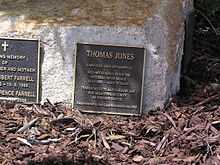The boy Jones
Edward Jones (1824 – December 26, 1893), or The Boy Jones, as he was called by the British newspapers of the early Victorian era, was a notorious intruder into Buckingham Palace between 1838 and 1841. He later became the subject of a children's book and the film The Mudlark and the full story of his activities has been told in Jan Bondeson's 2010 book Queen Victoria's Stalker.
Biography
Beginnings

Edward Jones was the son of a tailor in Westminster.
Arrests
In 1838, aged approximately 14, he entered Buckingham Palace, disguised as a chimney sweep. He was caught by a porter in the Marble Hall and, after a chase, captured by the police in St James's Street, with Queen Victoria's underwear stuffed down his trousers.[1] He was brought before Queen Square Police Court on 14 December. It turned out that he had frequently mentioned his intention to enter the palace to his employer, a builder. Although he had apparently stolen linen and a regimental sword from the palace, he was acquitted by the jury.[2]
On 30 November 1840, nine days after the birth of Queen Victoria's first child, Princess Victoria, he "scaled the wall of Buckingham Palace about half-way up Constitution Hill", entered the palace, and left it undetected. On 1 December 1840, he broke in again. Shortly after midnight a nurse discovered him under a sofa in the Queen's dressing room and he was arrested. His father's plea of insanity being without success, he was sentenced to three months in a house of correction. The 1840 incident caused a stir because initially it was feared that it might affect the Queen, happening so shortly after childbirth.[2]
Before his release from Tothill Fields Prison on 2 March 1841, attempts were made to persuade Edward Jones to join the Navy. On 15 March 1841, after a snack in one of the royal apartments, "the boy Jones" was caught by the reinforced police force guarding the palace. This time, he was sentenced to three months hard labour. This third incident caused a furore, and three additional palace sentries were appointed.[2]
Later life
After his second release, he refused an offer of £4 a week (£317 today) to appear in a music hall, and a short time later, he was caught loitering in the vicinity of Buckingham Palace.[3] He was sent to do duty in the Navy and consequently served on HMS Warspite, Inconstant, and Harlequin,[4] but, after a year, he found an opportunity to walk from Portsmouth to London. Having been caught before he reached the palace, he was sent back to his ship. He was last mentioned in the newspapers in 1844, when he was rescued after going overboard between Tunis and Algiers.[3]
Jones became an alcoholic and a burglar, and later went to Australia, where he became the town crier of Perth.[1]
Notoriety
Jones became the subject of numerous accounts in newspapers and satirical magazines[2][5] and inspired a children's book[6] and a film called The Mudlark. In an allusion to the famous Renaissance architect Inigo Jones, it was suggested that because of his "extraordinary powers of finding an entrance into the palace" he must be "a descendant of In-I-Go Jones".[7][8]
Death

In the 1880s, Edward Jones adopted the name 'Thomas Jones' in a vain attempt to escape his unwanted notoriety. He died on Boxing Day 1893 in Bairnsdale, Australia, after falling off the parapet of the east side of the Mitchell River bridge while drunk and landing on his head.[9] It was reported in the Bairnsdale Advertiser that he struck his head on a piece of quartz as he fell to the ground which was a distance of about 12 feet.[10]
Dr. Duncan performed the post mortem and made note of a two inch long wound over the parietal bone and that the cause of death was concussion of the brain. Death was determined not to have been instant and the deceased had a hand full of thistles, which he had seized after falling.[10]
He is buried at the Bairnsdale Cemetery in an unmarked grave, the exact location unrecorded.
It is curious that his memorial plaque says that he entered Windsor Castle, while all evidence says that it was Buckingham Palace that he entered.
See also
References
- ↑ 1.0 1.1 "Story of Boy Jones who stole Queen Victoria's underwear". BBC. 2 February 2011., citing Dr Jan Bondeson's 2010 book Queen Victoria's Stalker: The Strange Case of the Boy Jones (ISBN 978-1606350775)
- ↑ 2.0 2.1 2.2 2.3 Dickens, Charles (5 July 1885) "The boy Jones", All the Year Round, pp. 234–37.
- ↑ 3.0 3.1 Strachey, Lytton (1921) Queen Victoria.
- ↑ Thomas Murphy, Paul. "Jones, Edward". Oxford University Press. Retrieved 5 February 2014.
- ↑ Punch, Volume 1: July–December 1841.
- ↑ Howard, Joan (1943) The Boy Jones, New York: Viking.
- ↑ "It was Jones's extraordinary powers of finding an entrance into the palace, that caused Samuel Rogers to declare that he must be a descendant of the illustrious in-i-go." — Dickens, Charles (5 July 1885) "The boy Jones", All the Year Round, p. 236.
- ↑ Raikes, Thomas (1857). A Portion of the Journal Kept by Thomas Raikes, Esq., from 1831 to 1847. London: Longman, Brown, Green and Longmans. p. 136.
Lady Sandwich wittily wrote that he must be a descendant of In-I-Go Jones, the architect.
- ↑ Bondeson, Jan. "The strange tale of the first royal stalker". Express.co.uk. Retrieved 30 January 2014.
- ↑ 10.0 10.1 "Fatal Accident". The Bairnsdale Advertiser. 28 December 1893.